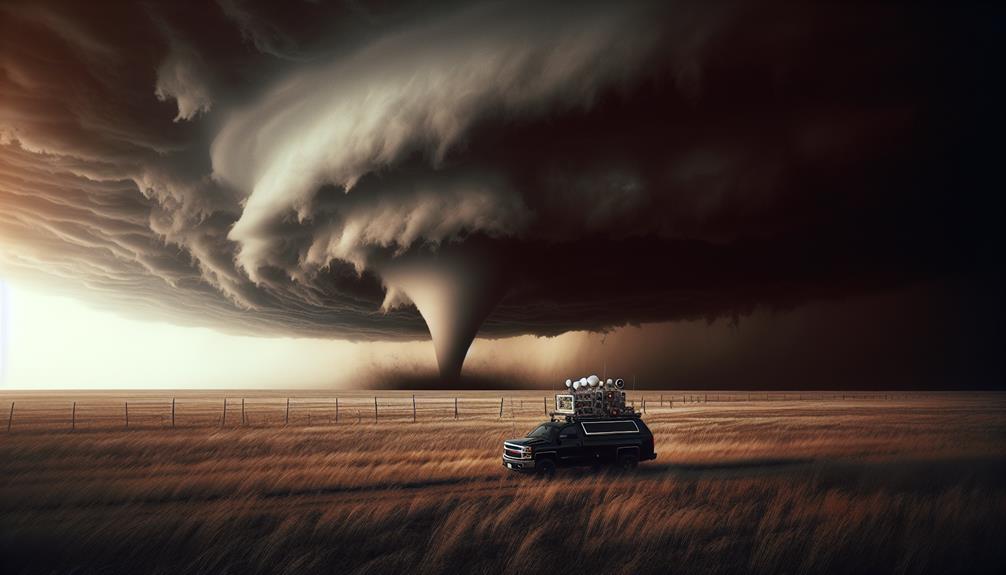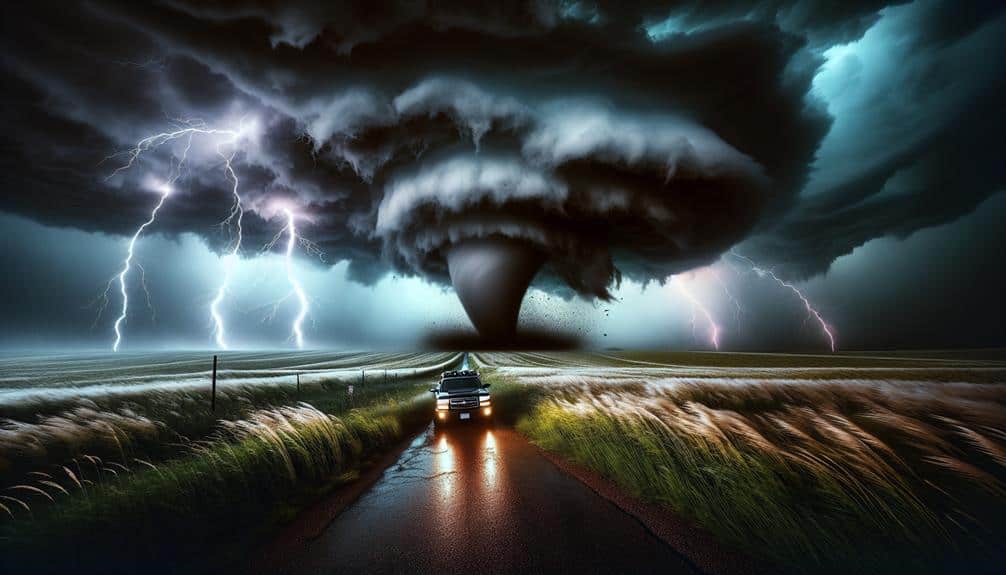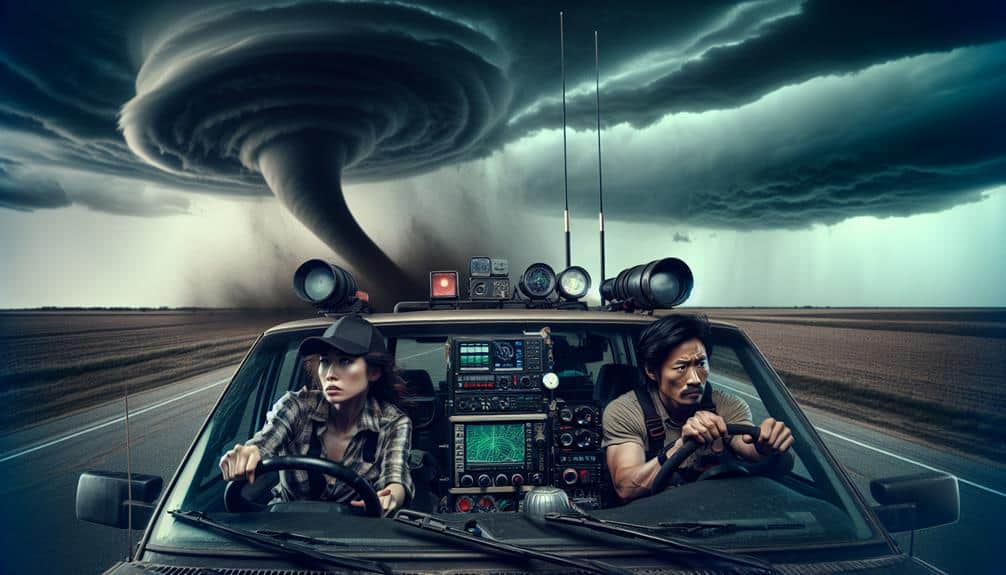We've analyzed the top three personal accounts of storm chasers, revealing essential elements of storm chasing. 'Surviving the Tornado' highlights the critical need for real-time data analysis and swift decision-making to maximize safety. 'The Heart of the Storm' emphasizes using high-resolution radar imagery and GPS tracking for predicting storm behavior and maneuvering close encounters. 'Chasing Lightning Dreams' combines advanced meteorological models and emergency response protocols, ensuring coordinated efforts during perilous chases. These accounts exemplify a calculated dance with nature's fury and the importance of preparation; continue further to grasp the depth of these storm chasers' harrowing experiences.
Key Points
- "The Man Who Predicts Storms" by Ken Cole: A gripping account of a meteorologist who uses cutting-edge technology to forecast tornadoes.
- "The Last Storm Chaser" by Jenna Blum: A personal narrative focusing on the emotional and physical challenges faced during storm chases.
- "Into the Storm" by Reed Timmer: Chronicles the thrilling and dangerous experiences of a renowned storm chaser.
- "Storm Chaser" by Warren Faidley: An in-depth look at the life of a professional storm chaser capturing extreme weather events.
Surviving the Tornado
Surviving a tornado requires careful preparation, real-time data analysis, and swift decision-making. We start by identifying shelter options and implementing safety precautions. Basements or storm cellars offer the highest level of protection, followed by interior rooms on the lowest floor without windows. Mobile homes, vehicles, and open spaces significantly increase risk and should be avoided.
Real-time data analysis is essential. Using Doppler radar and weather alerts, we track storm patterns and issue timely warnings. Emergency response protocols must be in place, including evacuation plans and designated shelters. Each family member should know their role and the location of emergency supplies, such as water, non-perishable food, and first-aid kits.
Community support plays a crucial role in survival. Local governments and organizations should coordinate efforts to provide resources and information. Establishing communication networks ensures timely dissemination of warnings and updates. Neighborhood watch programs can enhance safety by pooling resources and sharing responsibilities.
The Heart of the Storm
In the heart of the storm, we rely on high-resolution radar imagery and advanced meteorological models to pinpoint tornado genesis and track its path with unparalleled accuracy. This precise data allows us to minimize risk, though the adrenaline rush is inevitable.
Each storm chase is a calculated dance with nature's fury, balancing the thrill of the hunt with the imperative for safety.
Our methodology involves:
- High-Resolution Radar Imagery: By utilizing Doppler radar, we can detect rotation within thunderstorms, offering real-time updates on storm structure and potential tornado formation.
- Advanced Meteorological Models: These models simulate atmospheric conditions, enabling us to predict storm behavior and adjust our strategy accordingly.
Close calls aren't uncommon in our line of work. Despite meticulous planning, the unpredictable nature of storms means we sometimes find ourselves inches from danger. However, the freedom to explore and understand these phenomena firsthand is what drives us.
Every data point collected, every close encounter, adds to our collective knowledge and enhances our predictive capabilities. By continually refining our techniques, we aim to push the boundaries of what's possible in storm chasing.
Chasing Lightning Dreams
Pursuing lightning dreams, by utilizing high-speed cameras and lightning mapping arrays to capture and analyze the complexities of electrical discharges within storms. These advanced technologies enable us to document the fleeting moments when atmospheric conditions align to produce lightning. The adrenaline rush experienced while chasing danger is unparalleled, but it's the data gathered that provides the real thrill.
Our high-speed cameras, capable of recording thousands of frames per second, unveil the intricate branching patterns and rapid movement of lightning bolts. These visual records, when combined with lightning mapping arrays, offer a three-dimensional perspective of the electrical discharges. The mapping arrays use a network of sensors to pinpoint the exact locations of lightning strikes, allowing for precise spatial analysis.
In the field, we encounter extreme weather firsthand, capturing beauty in its rawest form. Each storm presents a new opportunity to expand our understanding of electrical phenomena. The data collected not only satisfies our scientific curiosity but also contributes to broader meteorological research, enhancing predictive models for storm behavior.
Chasing lightning dreams isn't just about the adrenaline rush; it's about pushing the boundaries of our knowledge and capturing the awe-inspiring power of nature.
Frequently Asked Questions
What Equipment Do Storm Chasers Typically Carry?
We always carry essential gear like anemometers, GPS devices, and first-aid kits. The technology used includes Doppler radar, mobile weather stations, and high-resolution cameras. These tools guarantee we track storms accurately and stay safe.
How Do Storm Chasers Predict Storm Paths?
How do we predict storm paths? We analyze weather patterns using advanced technology, interpret historical data, and apply meteorological principles. This data-driven approach lets us project storms' paths accurately, helping us navigate the unpredictable with freedom.
What Type of Training Is Required to Become a Storm Chaser?
To become a storm chaser, we need extensive meteorology knowledge and training in safety protocols. Understanding weather patterns and hazards guarantees we can navigate storms effectively, minimizing risks while maximizing data collection for research and forecasting.
Are There Any Legal Restrictions on Storm Chasing?
Ironically, while we chase ultimate freedom in storm chasing, legal implications can restrict our adventures. We must adhere to safety measures and local laws, ensuring public safety and minimizing risks—essential for safeguarding ourselves and others during extreme weather events.
How Do Storm Chasers Communicate With Each Other During a Chase?
We use various communication methods like radios and mobile apps for real-time weather updates. Team coordination is essential, so we establish emergency protocols to guarantee everyone's safety during the chase. Efficient communication maximizes our freedom to operate effectively.


